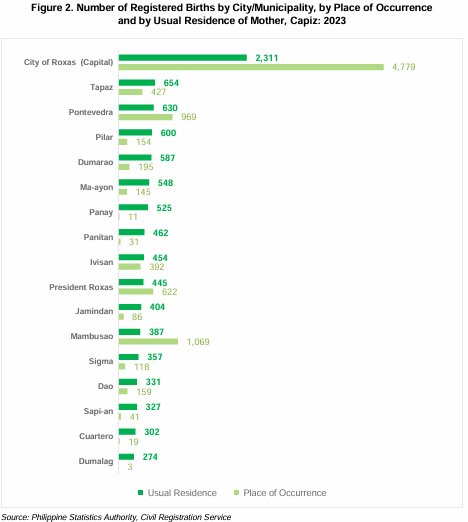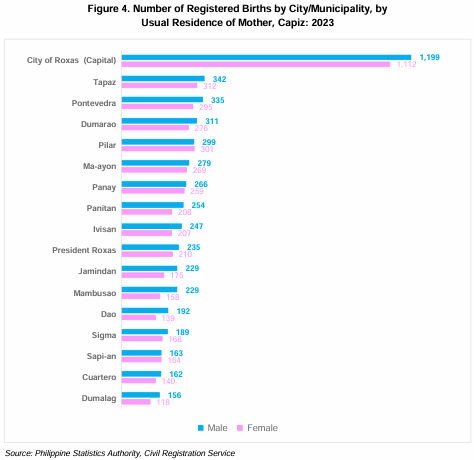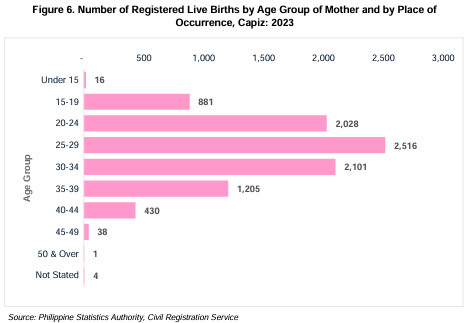REGISTERED BIRTHS IN CAPIZ INCREASED
In 2023, the total number of registered births in Capiz saw a 2.2 percent increase, equating to 204 additional births and a total of 9,598 registered births, up from 9,394 in 2022. This upward trend in the last two years is evident in Figure 1, which illustrates the five-year trend. As the figure shows, registered births decreased from 2019 to 2021 before beginning to recover in 2022 and continuing to rise in 2023. However, these recent increases have not yet brought the numbers back to the peak observed in 2019.

HIGHEST OCCURRENCE OF BIRTHS RECORDED IN THE CITY OF ROXAS
Among the 18 city/municipalities of the province, the city of Roxas recorded the highest number of registration with 2,311 births which composed the 24.1 percent of the overall registered births. Conversely, the municipality of Dumalag posted the least number of registration with 274 births or 2.9 percent. (Figure 2)

MORE MALES WERE BORN THAN FEMALES
By sex, male registration has accumulated a total of 5,087 or 53.0 percent of the total birth registration, while 4,511 were recorded on female registration or 47.0 percent of the total birth registration in the province of Capiz. (Figure 3) There was more male registration than female registration for 2023. Meaning there are approximately 113 men for 100 women. By city and municipalities in the province of Capiz, Roxas City has the highest record on male and female registration, followed by the municipalities of Mambusao and Pontevedra. The municipality of Dumalag registered the lowest male and female registration accounting for only 0.03 percent of the total provinces registration.


In terms of residence of the mother, the City of Roxas recorded the highest number of male births in 2023, with 1,199 babies, representing 23.6 percent of the total male births in Capiz. Following Roxas City, Tapaz reported 342 male births, or 6.7 percent of the total. Subsequently, Pontevedra, Dumarao, and Pilar municipalities recorded 335 (6.6 percent), 311 (6.1 percent), and 299 (5.9 percent) male births, respectively.In contrast, Dumalag and Cuartero municipalities reported the lowest numbers of male births, with 156 (3.1 percent) and 162 (3.2 percent), respectively. Similarly, Roxas City also reported the highest number of female births, with 1,112 babies, or 24.7 percent of the total female births in Capiz. This was followed by Tapaz, with 312 (6.9 percent), and Pilar municipality, with 301 (6.7 percent). Conversely, Dumalag and Dao municipalities reported the lowest numbers of female births, with 118 (2.6 percent) and 139 (3.1 percent), respectively. Male births outnumbered female births in fifteen (15) city/municipalities except from the two (2) municipalities: Pilar and Sapi-an.
MOST NUMBER OF BIRTHS REGISTERED IN OCTOBER
In 2023, most registered births occurred in October with 895 births, accounting to 9.7 percent of the total in the province. It was followed by the months of January with 9.4 percent and September with 9.1 percent of the total registered births. On the other hand, the month of February had the least number of births contributing only of 7.2 percent to the total. (Figure 5)

MAJORITY OF BABIES WERE BORN TO MOTHERS AGED 25-29 YEARS OLD
In 2023, Capiz faced a trend of teenage pregnancies, with a total of 881 live births recorded from mothers aged 15 to 19. An additional 16 live births were registered from mothers under the age of 15. Conversely, the data reveals that the peak birth rate in Capiz was observed among women aged 25 to 29, with 2,516 live births. The 30 to 34 age group followed closely, registering 2,101 live births. However, a clear and consistent decline in live births was noted as maternal age increase beyond these peak groups. (Figure 6)

MAJORITY OF BABIES WERE MEDICALLY ATTENDED AND DELIVERED IN A HEALTH FACILITY
Concerning birth attendance in Capiz in 2023, Health Professionals were present for 95.1 percent of deliveries. Following this, Traditional Birth Attendants attended to 4.8 percent, with the remaining 0.1 percent assisted by other types of attendants.
Similarly, when considering the site of delivery, 94.7 percent of births took place in a health facility, 5.2 percent occurred at home, and 0.03 percent were accounted for in other locations.

